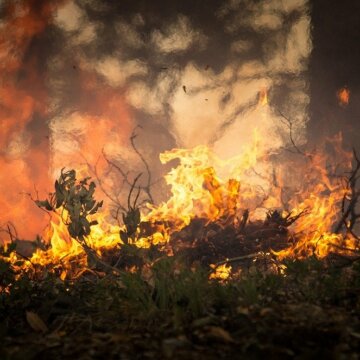- About
- Topics
- Picks
- Audio
- Story
- In-Depth
- Opinion
- News
- Donate
- Signup for our newsletterOur Editors' Best Picks.Send
Read, Debate: Engage.
| topic: | Natural disaster |
|---|---|
| located: | USA |
| editor: | Yair Oded |
This year’s fire season has surpassed any other in recorded history, with multiple fires blazing across California, Oregon, and Washington, leaving at least 8 people dead and many thousands displaced.
In California alone, 7,657 fires have burned over 2.5 million acres of land since the beginning of the year, which is a 2,000 per cent increase compared to this time last year, and the highest number of acres burned in the state’s history. In Oregon, an estimated 900,000 acres have been decimated so far, which is close to twice the amount of land burned in the state in an average fire season, as reported by The Guardian.
As of Thursday afternoon, the wildfires have cost the lives of at least 8 people across all three states, including a one-year-old boy who was killed in the Cold Springs Fire in northern Washington and have led to the evacuation of tens of thousands of people. In California, the 28 fires currently raging have resulted in the evacuation of 64,000 people, Daniel Berlant, a spokesman for the California Department of Forestry and Fire Protection, told the LA Times. At least a dozen people are reported missing.
In all three states, entire towns were reportedly razed to the ground by the infernos, and many more could be added to the list as the fires progress.
As a result of the fires, air quality across the West has been significantly compromised, and Martian orange glows, like the one that hovered over San Francisco earlier this week, can be seen across the sky due to high concentrations of ash and smoke, the Bay Area Air District reports. The poor air quality disproportionately affects workers in the agricultural sector, many of whom are migrants, who have no option but to leave their homes. It also makes people far more vulnerable to coronavirus and has been linked with exacerbated symptoms, such as coughing, thus increasing the likelihood they will infect people in their vicinity.
The majority of the fires are ignited by human activities, while some are started by utility malfunctions and accidents and others occur naturally due to lightning strikes. But climate scientists indicate that it is the worsening climate crisis that creates the conditions affecting the magnitude, severity, and duration of the fires. Prolonged droughts and increasingly high temperatures fuel the fires by creating an accumulation of dried leaves and other forms of kindling. This was the case in California, where a record-breaking heatwave preceded the fires. Erratic weather patterns and unexpected rainstorms also bring about growth spurts of vegetation that is then turned to fuel when temperatures rise.
State leaders have been vocal about their commitment to battling the unfurling disaster. California Governor Gavin Newsom has also highlighted his state’s obligation to tackle the climate crisis, understanding its inextricable link to the wildfires. “Never have I felt more of a sense of obligation and a sense of purpose to maintain California’s leadership not only nationally but internationally to face climate change head-on,” Newsom stated on Tuesday.
Alas, grossly underfunded state governments find themselves strapped and unable to tame the blazes. As a result, their emergency service agencies often have to make the tough call of choosing where to deploy. On Wednesday, Oregon Governor Kate Brown made an official request for assistance from the federal government, warning that “[T]his could be the greatest loss of human lives and property due to wildfire in our state’s history.”
But whatever aid the Trump administration does decide to extend might not be sufficient considering the fact that it had, for years, drained the Federal Emergency Management Agency (FEMA), funnelling millions from its budget to Immigration and Customs Enforcement.
It is important to note that the wildfires raging in the West are coinciding with a brutal hurricane season, first-ever September snowstorms in the middle of the country, and a pandemic that continues to wreak havoc throughout the nation.
In the reality of a warming planet and emaciated ecosystems, overlapping disasters can only be expected to occur more frequently and hit us more potently. All the while, socio-economic and racial disparities ensure that the most vulnerable segments of society experience the brunt of the chaos and are allocated the least resources to contend with it.
Image by skeeze

